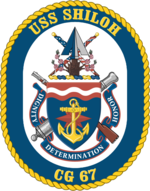Loading AI tools
US Navy guided missile cruiser From Wikipedia, the free encyclopedia
USS Shiloh (CG-67) is a Ticonderoga-class guided missile cruiser of the United States Navy, named in remembrance of the Battle of Shiloh during the American Civil War. She was built at the Bath Iron Works in Bath, Maine.
 USS Shiloh on 25 April 2003 | |
| History | |
|---|---|
| Name | Shiloh |
| Namesake | Battle of Shiloh |
| Ordered | 16 April 1987 |
| Builder | Bath Iron Works |
| Laid down | 1 August 1989 |
| Launched | 8 September 1990 |
| Acquired | 24 April 1992 |
| Commissioned | 18 July 1992 |
| Homeport | Joint Base Pearl Harbor–Hickam |
| Identification |
|
| Motto | Making Excellence a Tradition |
| Status | in active service |
| Badge |  |
| General characteristics | |
| Class and type | Ticonderoga-class cruiser |
| Displacement | Approx. 9,600 long tons (9,800 t) full load |
| Length | 567 feet (173 m) |
| Beam | 55 feet (16.8 meters) |
| Draft | 34 feet (10.2 meters) |
| Propulsion |
|
| Speed | 32.5 knots (60 km/h; 37.4 mph) |
| Complement | 30 officers and 300 enlisted |
| Sensors and processing systems |
|
| Armament |
|
| Aircraft carried | 2 × MH-60R Seahawk LAMPS Mk III helicopters. |
With her guided missiles and guns, she is capable of facing and defeating threats in the air, on or under the sea, and ashore. She also carries two Seahawk LAMPS multi-purpose helicopters, mainly for anti-submarine warfare (ASW).
On 3 September 1996, while in the Carl Vinson carrier battle group, Shiloh launched six Tomahawk cruise missiles in Operation Desert Strike against Iraq.

She deployed with the Battle Group again in July 2002, and was among the first cruisers to launch missiles in Operation Iraqi Freedom. In March 2003 Shiloh was assigned to Cruiser-Destroyer Group Three.[1] The Shiloh returned to her homeport San Diego, California on 25 April 2003, ending an unusually long nine-month deployment.
In January 2005, she participated in Operation Unified Assistance, rendering aid to those who suffered from the 26 December 2004 tsunami off the coast of Aceh, Indonesia. Shiloh was one of the first American ships to arrive on scene.
On 22 June 2006, a Standard Missile Three (or SM-3) launched from Shiloh intercepted a multi-stage ballistic missile launched from the Pacific Missile Range Facility at Barking Sands, Hawaii.[2]
In August 2006, she arrived on station at Yokosuka Naval Base in Yokosuka, Japan, replacing USS Chancellorsville, as part of a joint U.S.-Japanese ballistic missile defense program.[3]
On 8 July 2009, Petty Officer 1st Class Christopher Geathers fell from the ship's fantail into Tokyo Bay while rigging shore power cables. A two-and-a-half-day search failed to locate Geathers and he was declared missing and later was declared dead.[4] A Navy investigation, led by Rear Admiral Kevin Donegan, commander of Task Force 70, found that the accident was preventable, in part because Shiloh personnel had observed Geathers working without proper safety equipment, but had failed to intervene. Nevertheless, the report did not recommend disciplinary action against any of the ship's crewmembers.[5]
In June 2017, a gas turbine systems technician named Peter Mims thought to have been lost at sea was found after seven days hiding in the engine room.[6][7] Following the Mims incident, several sailors contacted the Navy Times about severe morale problems on the ship to which they attributed the Mims incident. The Navy Times requested "command climate surveys" through a Freedom of Information Act request.
These surveys, completed voluntarily by sailors on the ship, reported extensive morale problems universally blamed on the CO, Captain Adam M. Aycock. Among the complaints were widespread depression and suicidal tendencies, a dysfunctional ship that sailors felt was ill-prepared for combat, an overworked and deeply stressed crew, and a constant worry of extreme punishment for minor infractions. Sailors were dismayed that despite a significant number of the ship's crew filing severely critical complaints of Aycock's leadership in the command climate surveys, the only action taken by the Navy was to counsel him. Capt. Aycock was relieved of command after completing his full 26-month tour.[8][9]
In 2020, a US Navy budget plan proposed putting Shiloh, as well as her sisters USS Monterey, USS Port Royal, and USS Vella Gulf, on a path to early decommissioning, as they had not been modernized.[10]
In December 2020 the U.S. Navy's Report to Congress on the Annual Long-Range Plan for Construction of Naval Vessels stated that the ship was planned to be placed Out of Commission in Reserve in 2024.[11]
In the US Navy's 2024 proposed budget, presented in 2023, Shiloh was proposed for retirement. Navy Undersecretary Erik Raven stated that this was due to the ship's "material condition, life remaining, cost, ... time to upgrade ... and the warfighting value."[12]
September 2023, USS Shiloh departs Yokosuka, Japan after 17 years of forward-deployed service. She will be homeported in Pearl Harbor, Hawaii.[13] Shiloh is projected to be inactivated during FY2025.[14]
Shiloh has earned the following awards during her service life:
Seamless Wikipedia browsing. On steroids.
Every time you click a link to Wikipedia, Wiktionary or Wikiquote in your browser's search results, it will show the modern Wikiwand interface.
Wikiwand extension is a five stars, simple, with minimum permission required to keep your browsing private, safe and transparent.